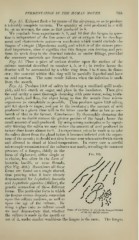Page 785 - My FlipBook
P. 785
FERMENTATION IN THE HUMAN MOUTH. 795
Exp. 1'2. Exhaust flask a by means of the air-pump, so as to produce
a tolerably complete vacuum. The quantity of acitl produced in a will
be, (jn an average, the same as that produced in h.
We conclude from experiments 8, 9, and 10 that the fungus in ques-
tion is independent of the free access of air or oxygen for its develop-
ment and characteristic action—a conclusion Avhich would exclude the
fungus of vinegar {^Mycoderma aeeti), and which is of the utmost prac-
tical importance, since it signifies that this fungus can develop and per-
form its work deep in the dentinal tubules or under fillings, provided
the necessary materials are furnished it.
Kvp. IS. Place a piece of carious dentine upon the surface of the
culture material described in number 4, 5, or 6 ; in twelve hours the
dentine will be surrounded by a white ring from 4 to 8 mm. in diam-
eter ; the material within this ring will be partially liquefied and have
an acid reaction. The same result follows when the infection is made
from the mouth.
Exp. 14-. Produce 10.0 of saliva by chewing a sterilized quill tooth-
pick, add 0.5 starch or sugar, and place in the incubator. Then give
the oral cavity a most thorough cleansing with pure water, using tooth-
pick, brush, and floss, the object being to free the mouth from micro-
organisms as completely as possible. Then produce again 10.0 saliva,
add 0.5 starch or sugar, and put in the incubator ; the amount of acid
produced in a given time will in the latter case be often as low as one-
fourth of that in the former. Conclusion : By thoroughly cleansing the
mouth we no doubt remove the greater portion of the fungi ; hence the
small amount of acid produced. By using strong antiseptics or by repeat-
edly filtering the saliva we may reduce the amount of acid produced in
twenty-four hours almost to 0. An experiment yet to be made is to take
the saliva direct from the gland before it becomes infected with the organ-
isms of the mouth ; it should not then become sour when mixed with starch
and allowed to stand at blood-temperature. In every case a careful
microscopic examination of the cultures was made, revealing the constant
presence of a fungus, chiefly in the
form of diplococci, either single or V^^- 408.
in chains, less often in the form of /' -
bacteria, bacilli, or even threads. ^ ,/ / / /
(See Fig. 408.) Sometimes all these j^'^^'^ry^ ' /
^^
forms are found on a single thread, •*•* ^ J /
thus proving what I have already / ^^ y ! ^
demonstrated for Leptothrix bvccaUs / I ^ i J
and Leptothrix c/igantea (Miller), the ' ^*^ ^ j***** ' \
genetic connection of these different / g^ i /^'
forms. The particular form in which / ^ ••*8
**tJ^L
the fungus occurs depends somewhat • ^ S <^9r^
\ ^ J'^ t
upon the culture medium, as well as "^ ^
u])on the age of the culture. By •••• | J^
using a glass tube as culture vessel
we may demonstrate that, whether '-""^ '^^ ^''l^U^TuJ^i^^.^^""^ '"''^'
the culture is made in the mouth or
out of it, under similar conditions the fungus is the same. The fungus


